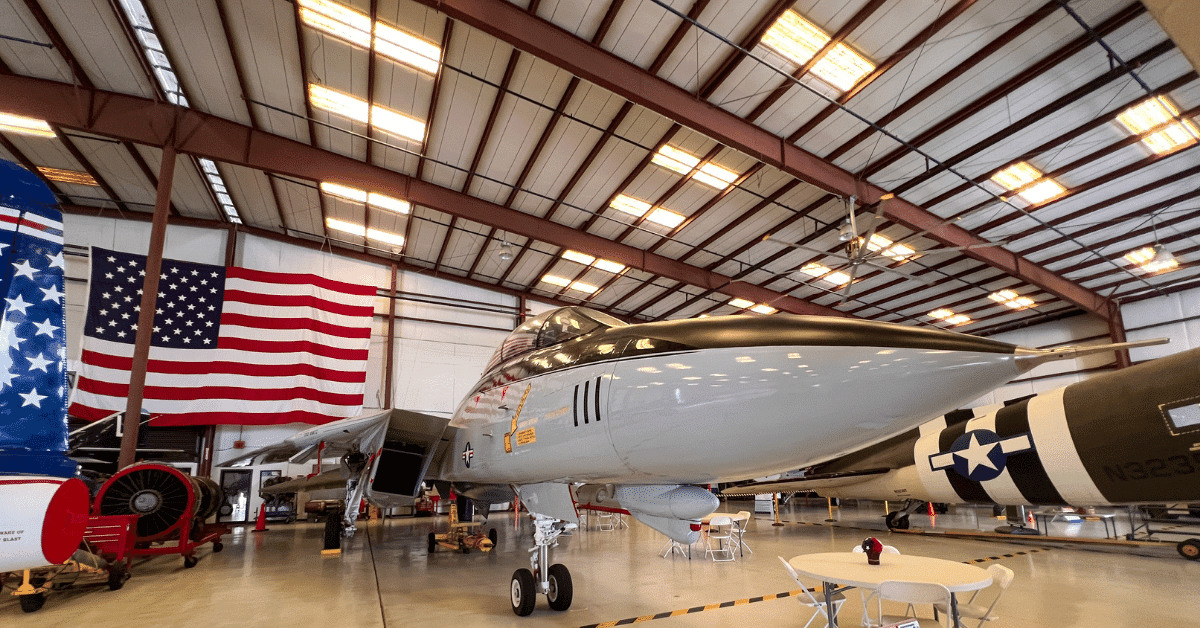Located in Titusville on Florida’s Space Coast is the Warbirds Museum. Operated by the Valiant Air Command, the museum holds many artifacts highlighting aviation history. Ranging from the earliest days of crewed flight to the present day.
Disclosure: Some links on our site are affiliate links. If you purchase a linked item, we will make a commission, at no extra charge to you.

The museum has a wide variety of planes, equipment, and personal belongings. Each tells a story of aerial combat. It is divided into different sections and is spread out over a few hangars. The first section you come to is an artifact room. Inside it holds mechanical equipment and personal items donated by families. All for the preservation of important moments in history. From propellers used for the first flights across the Atlantic. To the first circumnavigation of the globe. It’s hard to fathom the intrepid pilots who risked everything to accomplish what had never before been done. And at times using materials that today, we wouldn’t even consider.
The majority of the items here are from World War II. Both from the European theater and the Pacific. And not only from the Allies. A display case has items from the youngest flight instructor in Japan’s Imperial Navy. He was listed as Missing In Action during a recon mission over the South Pacific. His family notes that flying was his passion. One of his personal effects is his Samurai sword.
A Norden bombsight sits in one case. While very accurate in training and testing, the site didn’t have the same success in actual combat. Some bombs would fall over 1600 feet from their intended target. The bombsight was used in many daylight raids over Germany. I’m sure many of the nearly 2 million pounds of bombs dropped by the RAF and the US 8th Air Force were sighted by the Norden.
This greatly outpaced the little over 39 thousand tons dropped by the Luftwaffe on 17 cities, during the blitz. German aircraft dropped over 18 thousand tons of bombs on London, alone. During the Blitz, 43 thousand civilians were killed with another 139 thousand injured. A mere two weeks after the Blitz started, 150 thousand Londoners would sleep each night in the Underground, or subway. The aerial bombardment of the city would continue for eight months. But with amazing fortitude, residents removed almost a million tons of debris. By railway, they transported it to southeast England to build airfields. Many destroyed building sites, once cleared of rubble, were cultivated to grow vegetables. Easing food shortages caused by the war, these gardens became known as Victory Gardens.
A sand table display shows Pearl Harbor from the air on the morning of December 7th, 1941. The position of each ship shows what Kamikaze pilots would have seen as they started their bombing runs.
In the corner rests the wingtip of a P-40 aircraft used by the Tuskegee Airmen. The aircraft crashed during training due to a mechanical failure. Next to this exhibit is a small dedication to the 8th Air Force. The largest and most successful air armada in military history. At its peak, “The Mighty Eighth” had over 200,000 personnel assigned to it. On a single mission, it could launch more than 2000 four-engine bombers and 1000 fighters. A Roll of Honor book lists the names of those that served in this Numbered Air Force. To put that in perspective, that is 60% of the total currently serving in the whole US Air Force.
As you exit the artifact room and enter the first hangar, you are greeted with numerous planes. From as early as World War I up to the present. There are almost 50 restored and replica aircraft in the collection. It is one of the largest on the east coast.
The UH-19B Chickasaw was the first true transport helicopter. It played an important role in developing Army doctrine on air mobility. And battlefield employment using troop-carrying helicopters. Brought into operation during the Korean War, the helicopter exceeded expectations. The addition of a rescue hoist increased its role even more. In a unique twist, Orlando Helicopter created a camper conversion for civilians. It had a small kitchen and could sleep four. A partnership with Winnebago saw it rebranded as the Winnebago Heli-Home.
The F9F Panther fighter jet is one of the Navy’s first successful carrier-based jet fighters. It was also Grumman’s first jet fighter. It was used extensively during the Korean War by the US Navy and Marine Corp. It was also the first jet used by the Blue Angels demonstration team. They used it from 1949 to 1954.
The Killer “B” is a B-25 Mitchell. The B-25 remains one of the most iconic bombers of WWII. It was the type of plane used in Doolittles Raid. The raid proved Japan was not impenetrable from aerial attack. On April 18th, 1942, 16 Mitchells took off from the deck of the USS Hornet to attack the Japanese mainland. This was in retaliation for attacking Pearl Harbor. The bombers received no fighter escort and couldn’t carry enough fuel to return to the ship. After dropping their payloads, they were to continue on to mainland China. While the raid did little in damage, it was huge in psychological effect. For the Japanese, it raised fear and doubt that the archipelago could be defended. And it raised the morale in the United States. 14 of the 16 crews returned to the US or US forces elsewhere. One was lost in action. And one was captured and three of the five were later executed. Having lost all but one plane due to crashes, Lt. Colonel Doolittle was all but certain he would face a court-martial. He, instead, received a Medal of Honor and two promotions to Brigadier General.
The collection has a Fokker Dreidecker, or tri-plane in German. It is a replica of the plane made famous by The Red Baron. He earned 19 of his 80 aerial victories in WWI in this type of plane. Resting under one of the wings is a small red dog house with Snoopy sitting on top. This is a fun play on the song “Snoopy vs. The Red Baron” by The Royal Guardsmen.
An F-86F Sabre Jet is parked ready to take flight. It is the same type used by the Air Force SkyBlazers aerobatic display team. Aside from its history of performing aerial acrobatics, the Sabre was the first swept-wing fighter that could counter the Soviet MiG-15. In the skies over Korea, these two jets fought some of the earliest high-speed dogfights in history.

The flagship of Valiant Air Command, which operates the Warbirds Museum, is the Tico Belle. She, along with hundreds like her, flew airborne troops over to France on June 5th, 1944. A Douglas C-47 Skytrain, she was a militarized version of the Douglas DC-3 airliner. At 0407, at 500 feet above St Mere-Eglise, France, the Tico Belle dropped those brave men into Normandy. And history.
Her crew for that mission was:
- 1Lt Jay E. Bloch, Pilot, Oregon, 26
- 2Lt Oscar B. Hill, Co-Pilot, New York, 25
- S/Sgt John A. Quinn, Crew Chief, New Jersey, 21
- PFC JD Calhoun, Radio Operator, Ohio, 20
Whether realized or not, most people recognize the distinctive sound of a Huey. The Bell UH-1 helicopter, or Huey, first flew in 1956. It was conceived as a medical evacuation and utility helicopter. But soon became synonymous with combat operations in Vietnam. It became the workhorse of the Army during the Vietnam War. It was relied upon to “do anything a horse could do” and it lived up to expectations. From medevac and supply to troop transport and combat gun support.
I’m sure you’ve seen this on the tv show M*A*S*H. A small helicopter with litters on each side. The patient lays head first with a windscreen over his upper body. The Bell H-13 was originally designed as an observation and training helicopter. But, it was widely used as a medical evacuation helicopter with litters on the skids. It could move wounded patients quickly to M*A*S*H units for treatment. They soon became known as The Angel of Mercy. One pilot is noted to have evacuated 922 patients over 545 missions. Totaling 700 hours in just 14 months.
The OV-1C Mohawk was nicknamed the Whispering Death by her Vietcong enemies. It is an armed military observation and light-strike aircraft. It was intended to operate from unimproved runways in support of Army maneuver forces. There was an effort to return the Mohawk to operational use as a counter-insurgency aircraft. But the idea went nowhere.
The Warbirds Museum is continually restoring aircraft to their former glory. Through careful efforts, they are honoring our past, educating the future, and preserving our heritage. Make sure to stop by if you’re in Titusville on Florida’s Space Coast.

